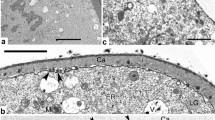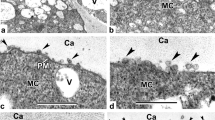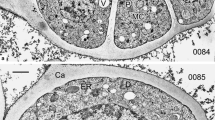Abstract
The aim of this study was to investigate in detail the pollen wall ontogeny in Impatiens glandulifera, with emphasis on the substructure and the underlying mechanisms of development. Sporopollenin-containing pollen wall, the exine, consists of two parts, ectexine and endexine. By determining the sequence of developing substructures with TEM, we have in mind to understand in which way the exine substructure is connected with function. We have shown earlier that physical processes of self-assembly and phase separation are universally involved in ectexine development; currently, we try to clear up whether these processes participate in endexine development. The data received were compared with those on other species. The ectexine ontogeny of I. glandulifera followed the main stages observed in many other species, including the late tetrad stage named “Golden gates”. It turned out that the same physico-chemical processes act in endexine development, especially expressed in aperture sites. Another peculiar phenomenon observed in exine development was the recurrency of micellar sequence at near-aperture and aperture sites where the periplasmic space is widened. It should be noted that, in the whole, the developmental substructures observed during the tetrad and early post-tetrad period are similar in species with columellate exines. Evidently, these basic physical processes proceed, reiterating again and again in different species, resulting in an enormous variety of exine structures on the base of a relatively modest number of genes. Granular and alveolar exines emerge on the base of the same basic processes but are arrested at spherical and cylindrical micelle mesophases correspondingly.










Similar content being viewed by others
Data availability
All relevant data are included in this manuscript and its supporting information is acceptable if this is the case.
References
Ariizumi T, Toriyama K (2011) Genetic regulation on sporopollenin synthesis and pollen exine development. AnnuRev Plant Biol 62:1–24. https://doi.org/10.1146/annurev-arplant-042809-112312
Blackmore S, Barnes SH (1985) Cosmos pollen ontogeny: a scanning electron microscope study. Protoplasma 126:91–99
Blackmore S, Barnes SH (1988) Pollen ontogeny in Catananche caerulea L. (Compositae: Lactuceae) I. Premeiotic phase to establishment of tetrads. Ann Bot 62:605–614
Blackmore S, Skvarla J (2012) John Rowley (1926–2010), palynologist extraordinaire. Grana 51:77–83. https://doi.org/10.1080/00173134.2012.661454
Blackmore S, Wortley AH, Skvarla JJ, Rowley JR (2007) Pollen wall development in flowering plants. New Phytol 174:483–498. https://doi.org/10.1111/j.1469-8137.2007.02060.x
Blackmore S, Wortley AH, Skvarla JJ, Gabarayeva NI, Rowley JR (2010) Developmental origins of structural diversity in pollen walls of Compositae. Plant Syst Evol 284:17–32. https://doi.org/10.1007/s00606-009-0232-2
Chaikovsky JV (2018) Autopoiesis. Society of scientific editions KMK, Moscow. Chaikovski JV. Avtopoez, In Russian
Collinson ME, Hemsley AR, Taylor WA (1993) Sporopollenin exhibiting colloidal organization in spore walls. Grana Suppl 1:31–39
Davantès NM, Sanchez C, d’Orlando A, Renard D (2019) Adsorption of hyperbranched arabinogalactan-proteins from plant exudate at the solid–liquid interface. Colloids Interfaces 3:49. https://doi.org/10.3390/colloids3020049
Dickinson HG, Sheldon JM (1986) The generation of patterning at the plasma membrane of the young microspore of Lilium. In: Blackmore S, Ferguson IK (eds) Pollen and Spores: form and function. Academic Press, London, pp 1–18
Dobritsa AA, Shrestha J, Morant M, Pinot F, Matsuno M, Swanson R, Møller BL, Preuss D (2009) CYP704B1 is a long-chain fatty acid v-Hydroxylase essential for sporopollenin synthesis in pollen of Arabidopsis. Plant Physiol. 151:574–589. https://doi.org/10.1104/pp.109.144469
Dobritsa AA, Geanconteri A, Shrestha J, Carlson A, Kooyers N, Coerper D, Urbanczyk-Wochniak E, Bench BJ, Sumner LW, Swanson R, Preuss D (2011) A Large-scale genetic screen in Arabidopsis to identify genes involved in pollen exine production. Plant Physiol (Lancaster) 157:947–970. https://doi.org/10.1104/pp.111.179523
Du G, Belić D, Giudice AD, Alfredsson V, Carnerup AM, Zhu K, Nyström B, Wang Y, Galantini L, Schillén K (2022) Condensed supramolecular helices: the twisted sisters of DNA. Angew Chem Int Ed 61:1–9. https://doi.org/10.1002/anie.202113279
Ellis M, Egelund J, Schultz CJ, Bacic A (2010) Arabinogalactan-proteins: key regulators at the cell surface? Plant Physiol 153:403–419. https://doi.org/10.1104/pp.110.156000
Fitzgerald MA, Knox RB (1995) Initiation of primexine in freeze-substituted microspores of Brassica campestris. Sex Plant Reprod 8:99–104
Gabarayeva NI, Hemsley AR (2006) Merging concepts: The role of self-assembly in the development of pollen wall structure. Rev Palaeobot Palynol 138:121–139. https://doi.org/10.1016/j.revpalbo.2005.12.001
Gabarayeva NI, Grigorjeva VV, Rowley JR, Hemsley AR (2009) Sporoderm development in Trevesia burckii (Araliaceae). I. Tetrad period: further evidence for the participation of self-assembly processes. Rev Paleobot Palynol 156:211–232
Gabarayeva NI, Grigorjeva VV, Rowley JR (2010a) Sporoderm development in Acer tataricum (Aceraceae). An interpretation. Protoplasma 247(1–2):65–81. https://doi.org/10.1007/s00709-010-0141-9
Gabarayeva NI, Grigorjeva VV, Rowley JR (2010b) A new look at sporoderm ontogeny in Persea americana Micelles and the hidden side of development. Ann Bot 105:939–955. https://doi.org/10.1093/aob/mcq075
Gabarayeva NI, Grigorjeva VV, Kosenko Y (2013) I. Primexine development in Passiflora racemosa Brot. Overlooked aspects of development. Plant Syst Evol 299:1013–1035. https://doi.org/10.1007/s00606-013-0757-2
Gabarayeva NI, Polevova SV, Grigorjeva VV, Blackmore S (2018) Assembling the thickest plant cell wall: exine development in Echinops (Asteraceae, Cynareae). Planta 248:323–346. https://doi.org/10.1007/s00425-018-2902-1
Gabarayeva NI, Grigorjeva VV, Shavarda AL (2019) Mimicking pollen and spore walls: self-assembly in action. Ann Bo 123:1205–1218. https://doi.org/10.1093/aob/mcz027
Gabarayeva NI, Grigorjeva VV, Lavrentovich MO (2020) Artificial pollen walls simulated by the tandem processes of phase separation and self-assembly in vitro. New Phytol 225:1956–1973. https://doi.org/10.1111/nph.16318
Gabarayeva NI, Grigorjeva VV (2021) An integral insight into pollen wall development: involvement of physical processes in exine ontogeny in Calycanthus floridus L., with an experimental approach. Plant J:736–753 https://doi.org/10.1111/tpj.15070
Galati BG, Zarlavsky G, Rosenfeldt S, Gotelli MM (2012) Pollen ontogeny in Magnolia liliflora Desr. Plant Syst Evol 298:527–534. https://doi.org/10.1007/s00606-011-0563-7
Gubatz S, Wiermann R (1992) Studies on sporopollenin biosynthesis in Tulipa anthers. 3. Incorporation of specifically labeled C-14 Phenylalanine in comparison to other precursors. Bot Acta 105:407–413
Hemsley AR (1998) Nonlinear variation in simulated complex pattern development. J Theor Biol 192:73–79
Hemsley AR, Gabarayeva NI (2007) Exine development: the importance of looking through a colloid chemistry “window”. Plant Syst Evol 263: 25–49. https://www.jstor.org/stable/23655636
Heslop-Harrison J (1972) Pattern in plant cell walls: morphogenesis in miniature. Proc Royal Inst GB 45:335–351
Ingber D (1993) Cellular tensegrity: defining new rules of biological design that govern the cytoskeleton. J Cell Sci 104:613–627. https://doi.org/10.1242/jcs.104.3.613
Jia QS, Zhu J, Xu XF, Lou Y, Zhang ZL, Zhang ZP, Yang ZN (2015) TEK directly regulates the expression of arabinogalactan proteins (AGPs) for nexine layer formation of pollen wall in Arabidopsis. Mol Plant 8:251–260. https://doi.org/10.1016/j.molp
Kauffman SA (1993) The origin of order. Oxford University Press, New York, Oxford
Kjellander R (1982) Phase separation of non-ionic surfactant solutions. A treatment of the micellar interaction and form. (Journal of the Chemical Society, Faraday Transactions 2: Molecular and Chemical Physics). J Chem Soc Faraday Trans 2(78):2025–2042. https://doi.org/10.1039/F29827802025
Kurakin A (2005) Self-organization versus watchmaker: stochastic dynamics of cellular organization. Biol Chem 386:247–254
Lavrentovich MO, Horsley EM, Radja A, Sweeney AM, Kamien RD (2016) First-order patterning transitions on a sphere as a route to cell morphology. Proc Nat Acad Sci USA 113:5189–94. https://doi.org/10.1073/pnas.1600296113
Lecuit T, Lenne PF (2007) Cell surface mechanics and the control of cell shape, tissue patterns and morphogenesis. Mol Cell Biol 8:633–644
Leszczuk A, Kalaitzis P, Kulik J, Zdunek A (2023) Review: structure and modification of arabinogalactan proteins (AGPs). BMC Plant Biol 23:45. https://doi.org/10.1186/s12870-023-04066-5
Li X, Fang Y, Al-Assaf S, Phillips GO, Nishinari K, Zhang H (2009) Rheological study of gum arabic solutions: Interpretation based on molecular self-association. Food Hydrocolloids 23:2394–2402. https://doi.org/10.1016/j.foodhyd.2009.06.018
Li J, Yu M, Geng LL, Zhao J (2010) The fasciclin-like arabinogalactan protein gene, FLA3, is involved in microspore development of Arabidopsis. Plant J 64:482–497. https://doi.org/10.1111/j.1365-313X.2010.04344.x
Li X, Zhang H, Jin Q, Cai Z (2017) Contribution of arabinogalactan protein to the stabilization of single-walled carbon nanotubes in aqueous solution of gum arabic. Food Hydrocolloids. https://doi.org/10.1016/j.foodhyd.2017.08.013
Li P, Schuler SB-M, Reeder SH, Wang R, Santiago VNS, Dobritsa AA (2018) INP1 involvement in pollen aperture formation is evolutionarily conserved and may require species-specific partners. J Experimental Bot 69:983–996. https://doi.org/10.1093/jxb/erx407
Li FS, Phyo P, Jacobowitz J, Hong M, Weng J-K (2019) The molecular structure of plant sporopollenin. Nat Plants 5:41–46. https://doi.org/10.1038/s41477-018-0330-7
Lintilhac PM (2014) The problem of morphogenesis: unscripted biophysical control systems in plants. Protoplasma 251:25–36
Majewska-Sawka A, Rodriguez-Garcia MI (2006) Immunodetection of pectin and arabinogalactan protein epitopes during pollen exine formation of Beta vulgaris L. Protoplasma 228:41–47
Mandelbrot BB (1982) The Fractal Geometry of Nature. WH Freeman and Co., San Francisco
Meyen SV (1984) Basic features of gymnosperm systematics and phylogeny as evidenced by the fossil record. Bot Rev 50. https://doi.org/10.1007/BF02874305
Mittal KL, Mukerjee P (1977) Wide world of micelles. In: Mittal KL (ed) Micellization, Solubilization, and Microemulsions. Plenum Press, N.-Y. & London, pp 11–31
Mondol P, Xu D, Duan L, Shi J, Wang C, Chen X, Chen M, Hu J, Liang W, Zhang D (2020) Defective pollen wall 3 (DPW3), a novel alpha integrin-like protein, is required for pollen wall formation in rice. New Phytol 225:807–822. https://doi.org/10.1111/nph.16161
Nadot S, Forchioni A, Penet L, Sannier J, Ressayre A (2006) Links between early pollen development and aperture pattern in monocots. Protoplasma 228:55–64. https://doi.org/10.1007/s00709-006-0164-4
Newman SA, Forgacs G (2009) Biological development and evolution, complexity and self-organization in. In: Meyers R (eds) Encyclopedia of complexity and systems science. Springer, NY, 524–548 https://doi.org/10.1007/978-0-387-30440-3_35
Newman SA, Comper WD (1990) ‘Generic’ physical mechanisms of morphogenesis and pattern formation. Development 110:1–18. https://doi.org/10.1242/dev.110.1.1
Paxson-Sowders DM, Owen HA, Makaroff CA (1997) A comparative ultrastructural analysis of exine pattern development in wild-type Arabidopsis and a mutant defective in pattern formation. Protoplasma 198:53–65
Paxson-Sowders DM, Dodrill CH, Owen HA, Makaroff CA (2001) DEX1, a novel plant protein, is required for exine pattern formation during pollen development in Arabidopsis. Plant Physiol 127:1739–1749 (PMC133577)
Pettitt JM, Jermy AC (1974) The surface coats on spores. Biol J Linn Soc 6:245–257
Pettitt JM (1979) Ultrastructure and cytochemistry of spore wall morphogenesis. In: Dyer AF (ed) The experimental biology of ferns. Academic Press, London, N.-Y, San Francisco, pp 211–252
Polevova SV, Grigorjeva VV, Gabarayeva NI (2023) Pollen wall and tapetal development in Cymbalaria muralis: the role of physical processes, evidenced by in vitro modelling. Protoplasma 260:281–298. https://doi.org/10.1007/s00709-022-01777-8
Pozhidaev AE (1993) Polymorphism of pollen in the genus Acer (Aceraceae). Isomorphism of deviant forms of Angiosperm pollen. Grana 32:79–85. https://doi.org/10.1080/00173139309429457
Pozhidaev AE (1995) Pollen morphology of the genus Aesculus (Hippocastanaceae). Patterns in the variety of morphological characteristics. Grana 34:10–20. https://doi.org/10.1080/00173139509429028
Pozhidaev AE (1998) Hypothetical way of pollen aperture patterning. 1. Formation of 3-colpate patterns and endoaperture geometry. Rev Palaeob Palynol 104:67–83. https://doi.org/10.1016/s0034-6667(99)00057-3
Pozhidaev AE (2000) Hypothetical way of pollen aperture patterning. 2. Formation of polycolpate patterns and pseudoaperture geometry. Rev Palaeobot Palynol 109:235–254
Pozhidaev A (2002) Hypothetical way of pollen aperture patterning. 3. A family-based study of Krameriaceae. Rev Palaeobot Palynol 127:1–23
Pozhidaev AE, Petrova NV (2023) Structure of variability of palynomorphological features within and beyond the genus Galeopsis L. Hjl. (Lamiaceae) in the context of divergent morphological evolution. Biol Bull Rev 13:63–80. https://doi.org/10.1134/S2079086423010061
Quilichini TD, Grienenberger E, Douglas CJ (2014) The biosynthesis, composition and assembly of the outer pollen wall: A tough case to crack. Phytochem 113 https://doi.org/10.1016/j.phytochem.2014.05.002
Quilichini TD, Grienenberger E, Douglas CJ (2015) The biosynthesis, composition and assembly of the outer pollen wall: A tough case to crack. Phytochem 113:170–182. https://doi.org/10.1016/j.phytochem.2014.05.002
Radja A (2020) Pollen wall patterns as a model for biological self-assembly. J Exper Zool Part B: Molecular and Developmental Evolution. https://doi.org/10.1002/jez.b.23005
Rowley JR (1973) Formation of pollen exine bacules and microchannels on a glycocalyx. Grana 13:129–138
Rowley JR (1990) The fundamental structure of the pollen exine. Plant Syst Evol Suppl 5:13–29
Rowley JR, Claugher D (1991) Receptor-Independent Sporopollenin. Bot Acta 104:316–323. https://doi.org/10.1111/j.1438-8677.1991.tb00236.x
Rowley JR, Dahl AO (1977) Pollen development in Artemisia vulgaris with special reference to glycocalyx material. Pollen Spore 19:169–284
Rowley JR, Prijianto B (1977) Selective destruction of the exine of pollen grains. Geophytol 7:1–23
Rowley JR, Flynn JJ, Takahashi M (1995) Atomic force microscope information on pollen exine substructure in Nuphar. Bot Acta 108:300–308
Routray P, Li T, Yamasaki A, Yoshinari A, Takano J, Choi W, Sams C, Robertsa D (2018) Nodulin intrinsic protein 7;1 is a tapetal boric acid channel involved in pollen cell wall formation. Plant Physiology 178:1269–1283. https://doi.org/10.1104/pp.18.00604
Shaklai M, Tavassoli M (1982) Lanthanum as an electron microscopic stain. J Histochem Cytochem 30:1325–1330
Skvarla JJ, Rowley JR (1987) Ontogeny of pollen in Poinciana (Leguminosae). I. Development of exine template. Rev Palaeobot Palynol 50:239–311
Stooke-Vaughan GA, Campàs O (2018) Physical control of tissue morphogenesis across scales. Curr Opin Genet Dev 51:111–119. https://doi.org/10.1016/j.gde.2018.09.002
Suzuki Y, Esumi Y, Koshino H, Ueki M, Doi Y (2008) Characterization of short-chain poly3-hydroxybutyrate in baker’s yeast. Phytochem 69(2):491–497
Suzuki T, Narciso J, Zeng W, van de Meene A, Yasutomi M, Takemura S, Lampugnani E, Doblin M, Bacic A, Ishiguro S (2017) KNS4/UPEX1: A type II arabinogalactan β-(1,3)-galactosyltransferase required for pollen exine development. Plant Physiol 173:183–205. https://doi.org/10.1104/pp.16.01385
Thompson DA (1917) On growth and form. Cambridge: University Press, Cambridge
Vinckier SA, Janssens SB, Huysmans S, Vandevenne A, Smets EF (2012) Pollen ontogeny linked to tapetal cell maturation in Impatiens parviflora (Balsaminaceae). Grana 51:10–24. https://doi.org/10.1080/00173134.2011.650194
Wang R, Dobritsa A (2018) Exine and aperture patterns on the pollen surface: their formation and roles in plant reproduction. Ann Plant Rev 1:1–40. https://doi.org/10.1002/9781119312994.apr0625
Wang R, Dobritsa AA (2021) Loss of THIN EXINE2 disrupts multiple processes in the mechanism of pollen exine formation. Plant Physiol 187:133–157. https://doi.org/10.1093/plphys/kiab244
Wang R, Owen HA, Dobritsa A (2021) Dynamic changes in primexine during the tetrad stage of pollen development. Plant Physiol kiab426:1–12. https://doi.org/10.1093/plphys/kiab426
Wilmesmeier S, Wiermann R (1997) Immunocytochemical localization of phenolic compounds in pollen walls using antibodies against p-coumaric acid coupled to bovine serum albumin. Protoplasma 197:148–159
Wittborn J, Rao KV, El-Ghazaly G, Rowley JR (1996) Substructure of spore and pollen grain exines in Lycopodium, Allium, Betula, Fagus and Rododendron investigated with Atomic Force and Scanning Tunnelling Microscopy. Grana 35:185–198
Zhou Q, Zhu J, Cui YL, Yang Z-N (2015) Ultrastructure analysis reveals sporopollenin deposition and nexine formation at early stage of pollen wall development in Arabidopsis. Sci Bull 60:273–276. https://doi.org/10.1007/s11434-014-0723-6
Zini LM, Galati BG, Zarlavsky G, Ferrucci MS (2017) Developmental and ultrastructural characters of the pollen grains and tapetum in species of Nymphaea subgenus Hydrocallis. Protoplasma 254:1777–1790. https://doi.org/10.1007/s00709-016-1074-8
Acknowledgements
This work was carried out in the framework of the institutional research project of the Komarov Botanical Institute of the Russian Academy of Sciences ‘Pollen and spores of living and fossil plants: morphology and development’ no. AAAA-A19-119080790048-7 on the equipment of the Core Facility “Cellular and Molecular Technologies in Plant Science” of the Komarov Botanical Institute (St. Petersburg).
Funding
Institutional research project of the Komarov Botanical Institute of the Russian Academy of Sciences.
Author information
Authors and Affiliations
Contributions
VVG: collecting and fixation of C. miralis material and preparing of ultrathin sections, fixations and embedding of models’ samples and preparing ultrathin sections, staining of all sections; DAB: taking TEM pictures; NIG: the principal analysis and writing the manuscript.
Corresponding author
Ethics declarations
Competing interests
The authors declare no competing interests.
Additional information
Handling Editor: Alexander Schulz
Publisher's note
Springer Nature remains neutral with regard to jurisdictional claims in published maps and institutional affiliations.
Rights and permissions
Springer Nature or its licensor (e.g. a society or other partner) holds exclusive rights to this article under a publishing agreement with the author(s) or other rightsholder(s); author self-archiving of the accepted manuscript version of this article is solely governed by the terms of such publishing agreement and applicable law.
About this article
Cite this article
Gabarayeva, N.I., Britski, D.A. & Grigorjeva, V.V. Pollen wall development in Impatiens glandulifera: exine substructure and underlying mechanisms. Protoplasma 261, 111–124 (2024). https://doi.org/10.1007/s00709-023-01887-x
Received:
Accepted:
Published:
Issue Date:
DOI: https://doi.org/10.1007/s00709-023-01887-x




